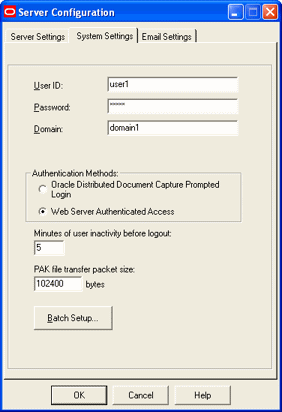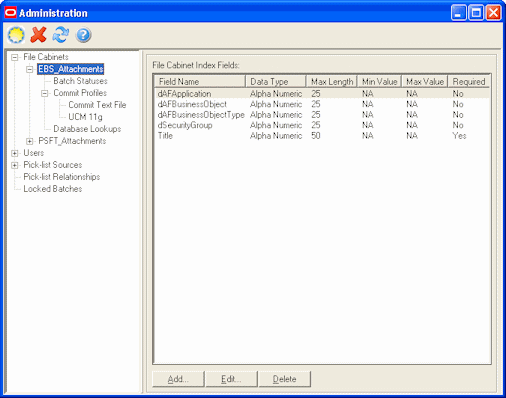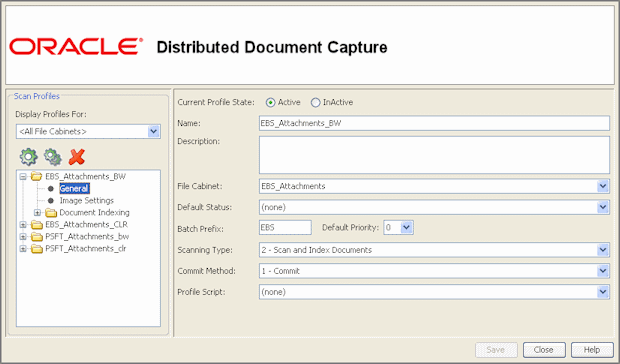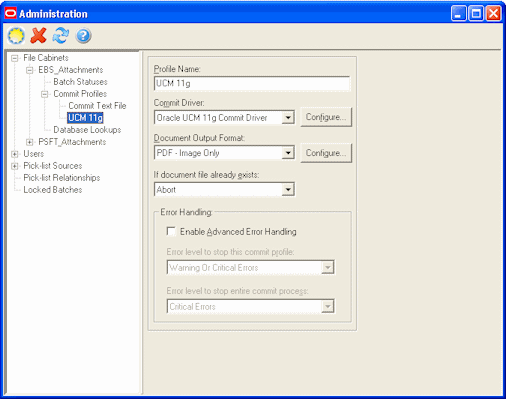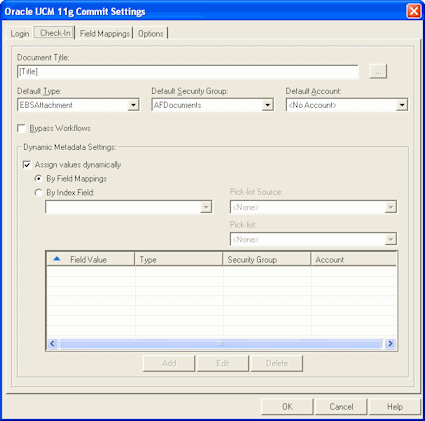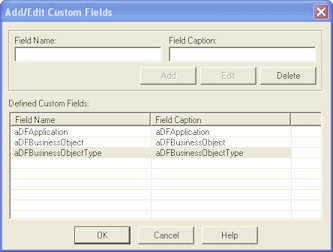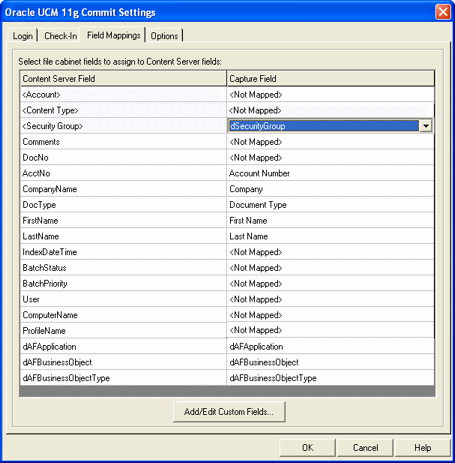6 Configuring the Managed Attachments Solution
This chapter describes how to configure the Managed Attachments solution. It covers the following topics:
-
Section 6.1, "System Requirements For Managed Attachments Solution"
-
Section 6.2, "Running Managed Attachments Installation Scripts"
-
Section 6.6, "Configuring Oracle Distributed Document Capture"
-
Section 6.9, "Uninstalling Adapter Components on Content Server"
6.1 System Requirements For Managed Attachments Solution
In addition to all other requirements listed in Section 1.6, the Managed Attachments solution includes the requirements listed in this section. For other system requirements, such as browsers, see the certification matrix at the following location:
http://www.oracle.com/technetwork/middleware/content-management/oracle-ecm-11gr1-.xls
Oracle I/PM 11g Release 1 (11.1.1 or higher)
Installation of Oracle I/PM 11g is required, even if configuring the Managed Attachments solution only. This is because AXF is part of the Oracle I/PM deployment.
Oracle UCM 11g Release 1 (11.1.1 or higher)
The Managed Attachments solution supports the following Oracle UCM search engines.
6.2 Running Managed Attachments Installation Scripts
This section describes running the following configuration scripts for the Managed Attachments solution:
-
AXF_ATTACHMENTS_CONFIG.sql, an AXF script that configures AXF elements such as solutions and commands.
-
AXF_EBS_ATTACHMENTS_CONFIG.sql, an Oracle E-Business Suite plug-in script that configures the Zoom menu to enable the Managed Attachments solution. (Applies to Oracle E-Business Suite use only.)
Follow these steps to run the scripts.
-
Locate the scripts in the folders specified below.
-
For Oracle E-Business Suite:
MW_HOME/ECM_HOME/axf/adapters/ebs/R11/MW_HOME/ECM_HOME/axf/adapters/ebs/R12/ -
For Oracle PeopleSoft:
MW_HOME/ECM_HOME/axf/adapters/psft/
-
-
Modify parameters in the AXF_ATTACHMENTS_CONFIG.sql script to match your environment.
-
Change the system name and port for the UCM_CONNECTION_STR parameter to match your Oracle UCM installation. The port number should correspond to that of the Oracle UCM Content Server's web server port. Change the
/idc/portion of the URL to match your Oracle UCM installation's web root (/ucm_web_root/). -
Change the system name and port for the RIDC_CONNECTION_STR parameter to match your Oracle UCM installation. The port number should correspond to that of the Oracle UCM Content Server's Intradoc server port that receives RIDC calls. (To find the value for the Oracle UCM server port, locate the IntradocServerPort config value in config.cfg.)
-
-
Log in to the AXF Configuration Database as the user who owns the Oracle I/PM schema and run the AXF_ATTACHMENTS_CONFIG.sql script.
To execute the script, enter:
@AXF_ATTACHMENTS_CONFIG.sqlNote:
For information about creating schemas during ECM installation, see "Creating Oracle Enterprise Content Management Suite Schemas" in Oracle Fusion Middleware Installation Guide for Oracle Enterprise Content Management Suite. -
If configuring the adapter for Oracle E-Business Suite, modify parameters in the AXF_EBS_ATTACHMENTS_CONFIG.sql script to match your environment.
-
Change the system name and port in the SolutionEndPoint parameter to match your AXF system and port.
-
Modify the EBS_instanceA value to one that uniquely identifies the Oracle E-Business Suite instance you are configuring.
-
-
If configuring the adapter for Oracle E-Business Suite, log in to the Oracle E-Business Suite database as the Oracle E-Business Suite plug-in schema user (AXF) and run the AXF_EBS_ATTACHMENTS_CONFIG.sql script.
To execute the script, enter:
@AXF_EBS_ATTACHMENTS_CONFIG.sql
6.3 Configuring the Oracle UCM Components
Follow the sections listed below to configure Managed Attachments solution Oracle UCM components and test the completed solution.
6.3.1 Enabling Oracle UCM Components
Oracle UCM components for the Managed Attachments solution include:
-
AppAdapterCore.zip (required)
-
AppAdapterEBS.zip (required only for Oracle E-Business Suite integration)
-
AppAdapterPSFT.zip (required only for Oracle PeopleSoft integration)
Follow these steps to enable the Oracle UCM components using Component Manager.
-
If upgrading from an earlier installation of the adapter, back up previous customizations, as described in Section 6.3.1.1.
-
Log in to Content Server as an administrator.
-
Select Admin Server from the Administration menu.
The Component Manager page displays.
-
Choose Integration.
The AppAdapterCore, AppAdapterEBS, and AppAdapterPSFT components are listed as Integration options.
-
Select the AppAdapterCore component to enable it. Also select the appropriate business application component (AppAdapterEBS.zip for Oracle E-Business Suite or AppAdapterPSFT.zip for Oracle PeopleSoft).
-
Click Update.
-
Restart Content Server.
-
Check the Content Server and database logs to ensure that no application adapter install errors occurred.
6.3.1.1 Backing Up Customizations Before Upgrading
If upgrading from a previous version of the adapter (Managed Attachments solution), perform these additional upgrade steps if needed before installing Oracle UCM components, as indicated in step 1 in Section 6.3.1.
-
Back up Content Server rule and profile customizations.
Installing the new adapter overwrites existing rules and profiles. If your previous installation includes customizations to Content Server rules and profiles, back up these rules and profiles using a CMU bundle before installing Oracle UCM components. After installation, create new rules and profiles, and manually apply any customizations.
-
Back up the config.cfg file.
This adapter release stores environment variables using a preferences.hda file instead of config.cfg. After installation, manually copy configuration preferences from config.cfg to preferences.hda.
-
Back up any other template or resource include customizations and modifications.
Some resource includes and templates have changed in this release. Manually set these customizations after installation.
6.3.2 Verifying Required Oracle UCM Components and Configuration
Follow these steps to verify that required Oracle UCM components are enabled on the Content Server.
-
Log in to Content Server as an administrator.
-
Click the Configuration for [Instance] link in the content server Administration tray.
-
In the Features And Components section, click Enabled Component Details.
-
From the details shown, verify that the following components are enabled. If a component is not listed, install and enable it according to its installation documentation.
The following components must be at or above the version level included with Oracle UCM 11gR1 release 11.1.1.4:
-
YahooUserInterfaceLibrary
-
CheckoutAndOpenInNative
-
CoreWebdav
-
NativeOsUtils
-
ContentFolios
-
-
In the User Admin applet, ensure that the roles below have the correct access level to the corresponding security groups.
In Content Server, select the Administration option from the main menu, choose Admin Applets, then User Admin. Select Security, then Permissions by Role.
-
AFAdmin: AFDocuments (RWDA) and no permissions on any other groups
-
AFDelete: AFDocuments (RWD) and no permissions on any other groups
-
AFWrite: AFDocuments (RW) and no permissions on any other groups
-
AFRead: AFDocuments (R) and no permissions on any other groups
-
6.3.3 Configuring the Preferences.hda File
Installing and enabling the AppAdapter component creates a default configuration file called preferences.hda.
Follow these steps to modify the preferences.hda file.
-
Open the preferences.hda file in the following directory:
UCM_Instance/data/appadapterThis file provides Oracle UCM adapter configuration options in the ResultSet sections described in Table 6-1.
Table 6-1 ResultSet Sections in Preferences.hda File
Section Description AFEnvironmentConfiguration
Use to configure Oracle UCM environment variables for the adapter.
For example, enable and configure scanning or AutoVue document viewing, and hide or display buttons for specified business entities.
For more information, see Table 6-2 and Section 6.7, "Customizing the Managed Attachments Solution."
AFRelationshipAttributes
Use to configure custom relationships between attached documents and business entities.
For example, enable attached document printing for certain business entities but not for other entities.
For more information, see Section 6.7.8, "Configuring Relationship Attributes."
AFRevisionSpecificEntities
Use to enable users to access the document version that was attached, even if the document was later updated.
For more information, see Section 6.7.9, "Configuring Revision-Specific Mode."
-
Scroll to the AFEnvironmentConfiguration ResultSet section, and edit the entries listed in Table 6-2 as needed. For more information about customizing the Managed Attachments solution using these variables, see Section 6.7.
Note:
You can specify preferences on a global, application, and application+business entity level. For more information and examples, see Section 6.7.1.Table 6-2 Preferences.hda Environment Variables
Field Default Value Description W
Specifies the access level to grant to all users if the AF_GRANT_ACCESS service's dPrivilege parameter is not specified. Valid values include: R (read), W (write), D (delete) and A (admin).
For more information, see Section B.4.1, "AFGrants Table."
0.5
Specifies the time in hours for which the user session remains available. The solution uses this value only if the AF_GRANT_ACCESS service's numHours parameter is not specified. Valid values are numbers with optional decimal.
For more information, see Section B.4.1, "AFGrants Table."
24
Specifies the maximum time in hours to grant the user access to the Managed Attachments screen. Valid values are numbers with decimal.
For example, suppose AppAdapterGrantHours is set to 1 hour and AppAdapterMaxGrantHours is set to 24 hours. If the user accesses the Managed Attachments screen from the business application at 12:00 (noon), dExpirationDate in the AFGrants Table is set to 13:00 and dMaxExpiration is set to 12:00 (noon) the next day. If at 12:30, the user performs an action (such as checking in a document), dExpirationDate changes to 13:30, and so on. The result is that the user can have access to the Managed Attachments screen up to 24 hours if at any given time the gap between two requests is less than one hour. Regardless, when 24 hours is reached, access is denied. This setting prevents a user from keeping access open for very long periods of time without user action, and prevents access from expiring if a user is actively using the system.
|
This is the internal delimiter, used to concatenate primary keys and values passed as parameters. See Section B.4.1, "AFGrants Table." The default delimiter is a | (pipe) character.
Enables document attachment scanning and importing through Oracle Distributed Document Capture. For configuration instructions, see Section 6.6. This entry specifies the web address to Oracle Distributed Document Capture.
Format:
ODDCURLPath=http://ODDC_host/ODDC_webcapture_addressExample:
ODDCURLPath=http://xyz/webcapture.asp1
Use to configure document attachment scanning and importing through Oracle Distributed Document Capture, as described in Section 6.6. In this entry, specify the scan action to perform, where:
-
1 = Scan
-
2 = Import
Enables AutoVue viewing of attached documents through Oracle AutoVue Web Version. For configuration instructions, see Section 6.5. This entry specifies the AutoVue servlet to run.
Format:
AutoVueURLPath=http://ucm_host name:port/web_root/jsp/autovue/csiApplet.jspExample:
AutoVueURLPath=http://ucm1.mycompany.com/idc/jsp/autovue/csiApplet.jspfalse
Specifies if the AutoVue icon displays in the Actions column of the Managed Attachments screen. For more information, see Section 6.5.
true
Specifies if the Detach button displays in the Managed Attachments screen.
true
Specifies if the Refresh button displays in the Managed Attachments screen.
true
Specifies if the New button displays in the Managed Attachments screen.
true
Specifies if the From Repository button displays in the Managed Attachments screen.
true
Specify if standard browser menu options are hidden in browser windows that open from the attachments display (true) or displayed (false).
true
Specifies if the Configure button displays in the Managed Attachments screen.
false
Specifies if the Scan button displays in the Managed Attachments screen.
-
-
Restart Content Server.
6.3.4 Testing the Managed Attachments Solution
Test the configuration for your selected business application by following the steps listed in the Oracle Fusion Middleware User's Guide for Oracle Application Adapters for Oracle Enterprise Content Management.
6.4 Configuring Authentication and Security
This section provides instructions on managing authentication and security for the Managed Attachments solution. It covers the following topics:
-
Section 6.4.3, "Securing Communications Between AXF and Oracle UCM"
-
Section 6.4.4, "Managing Business Application and Oracle UCM Users"
6.4.1 Configuring User Authentication
Business application users must have an Oracle UCM Content Server account to display the Managed Attachments screen within the supported business application entity. In addition, the authentication model configured for Content Server and the business application determines how users are authenticated the first time they activate managed attachments from a business application record:
-
Content Server configured for single sign-on: If the business application is not configured for single sign-on, the Oracle UCM single sign-on login prompt displays. (If the business application is configured for single sign-on, the user has been authenticated so no login prompt displays.)
-
Content Server not configured for single sign-on: The Content Server login prompt displays, regardless of the selected business application authentication model.
Note:
No user authentication is needed for AXF if security checks are properly configured, as described in Section 6.4, "Configuring Authentication and Security."
6.4.2 Configuring Document Security
When checking documents into Content Server through the Managed Attachments user interface, users specify their access by choosing one of two modes:
-
private (not shared): Users can access these documents only through their associated business application entity screens through the Managed Attachments user interface. Users (including the user who checks in a document) cannot search for or access a private document using any other standard Oracle UCM user interface. This is the default security mode when checking in a new document through the Managed Attachments user interface.
-
shared: These documents are more easily accessed than private documents, because their security is managed by Oracle UCM. In addition to access through their associated business application entity screens through the Managed Attachments user interface, any Oracle UCM user with a document's assigned security group access can search for and access the document using any standard Oracle UCM user interface.
Note:
Users can view only shared documents in AutoVue (if configured). They cannot view private documents. For details, see Section 6.5.Note:
Private (not shared) documents are automatically assigned to a special security group called AFDocuments, and users who have access to the business application entity are granted temporary access to the documents when they invoke the Managed Attachments user interface. In certain exceptional cases, an administrator might grant special users direct access to the AFDocuments security group by permanently assigning the AFRead, AFWrite, AFDelete, or AFAdmin roles for the AFDocuments security group, in which case the user could access a private document through any standard Oracle UCM user interface.
6.4.3 Securing Communications Between AXF and Oracle UCM
Follow these steps to enable trusted communication between the host on which AXF is running and the Oracle UCM server. On the Oracle UCM server, you have two options for this configuration step: either using the System Properties application or by editing the config.cfg file.
6.4.3.1 Using the Content Server System Properties Application
-
Open the System Properties utility for the Oracle UCM instance.
-
Select the Server tab.
-
Identify the AXF host by either entering a name in the Hostname Filter field or an address in the IP Address Filter field.
-
Click OK and restart Content Server.
6.4.4 Managing Business Application and Oracle UCM Users
Keep the following guidelines in mind when managing Oracle E-Business Suite or Oracle PeopleSoft users for Managed Attachments access (for example, when managing users in a central repository using single sign-on):
-
In order for business application users to access Managed Attachments functionality, their Oracle E-Business Suite or Oracle PeopleSoft user names MUST match their Oracle UCM user names.
-
When creating Oracle UCM users (global or local), add them with default roles. Do NOT select the AFRead, AFWrite, AFDelete, or AFAdmin roles.
The adapter dynamically assigns roles to the user: Roles are granted to the user based on dPrivilege's value when the AF_GRANT_ACCESS service is invoked (see Section B.4.1); or, if not specified, based on the configuration variable AppAdapterGrantPrivilege's value (see Section 6.3.3). Depending on the privilege (R, W, D, or A), a predefined role is dynamically assigned to the user.
Caution:
Do not delete the AFRead, AFWrite, AFDelete, AFAdmin roles from the system.6.5 Configuring Oracle AutoVue Document Viewing
This section covers the following topics:
6.5.1 About Configuring Oracle AutoVue
The default document viewing option for the Managed Attachments screen is the standard web rendition provided by Oracle UCM. For enhanced viewing options, the adapter also supports Oracle AutoVue through VueLink for Oracle UCM, where non-private attachments of virtually any document type are available for viewing, printing, collaboration, annotation, and mark up, delivered securely using Web technologies.
Important Points About the AutoVue/Adapter Integration
-
If configured, users can view all non-private attachments through AutoVue. For details on shared versus private documents, see Section 6.4.1.
-
The VueLink integration serves as a bridge that securely streams documents from the Content Server repository to AutoVue for viewing, digital markup and collaboration. Digital markups are saved in the Content Server repository and associated with the attached document.
-
By default, AutoVue is turned off in the Managed Attachments solution. You activate it in the preferences.hda file, by displaying the AutoVue icon and identifying the URL to the AutoVue servlet to launch when the user clicks the View in AutoVue icon.
-
As with other preferences settings, you can enable the AutoVue integration at the global, application, and business entity levels.
-
AutoVue trusts the user authentication against Oracle UCM. Once authenticated to Oracle UCM, no further authentication to AutoVue is required for users to view attached documents using AutoVue.
-
Viewing or annotating a document in AutoVue does not check it out or prevent it from being edited by others. Annotations are contained in a separate layer from their corresponding document.
6.5.2 Requirements For Oracle VueLink for Oracle UCM
Note:
The requirements listed in this section apply only if providing optional document viewing with the adapter through Oracle AutoVue.For complete installation requirements for integrating AutoVue viewing with Oracle UCM, see the system requirements section in the Oracle VueLink 20 for Oracle UCM System Administrator Manual. Requirements include:
-
Oracle AutoVue 20 (and any service packs for AutoVue 20).
-
Oracle UCM Release 11.1.1.4 (or Oracle UCM 11.1.1.3 plus Patch 9725318, UCM 11.1.1.3.0 patch (20100901-1504) available from My Oracle Support).
-
Oracle VueLink 20 for Oracle UCM, the AutoVue VueLink integration for Oracle UCM.
6.5.3 Enabling AutoVue For the Adapter
Follow these steps to enable and configure AutoVue document viewing globally, or for a specific application or business entity.
-
Configure the Oracle UCM/AutoVue integration.
Follow the procedures outlined in the Oracle VueLink 20 for Oracle UCM System Administrator Manual.
-
In the preferences.hda file, modify the global AutoVue setting, if needed. For general information, see Section 6.3.3.
-
Optionally specify application or business entity settings by adding new rows in the AFEnvironmentConfiguration resultset for the AppAdapterAutoVueIconVisible and AutoVueURLPath variables, where:
-
dAFApplication: Application in which to display or hide button
-
dAFBusinessObjectType: Business entity within application in which to display or hide button
Example 6-1 contains several AutoVue settings. The first entry hides the View in AutoVue icon globally. The next two entries enable and display the icon for the PSFT_Instance_A application. The last two entries enable and display the icon for the PSFT_Instance_B application, but only within its PIM business entity.
Example 6-1 AutoVue Entries in Preferences.hda File
AppAdapterAutoVueIconVisible false AutoVueURLPath http://ucm1.mycompany.com/idc/jsp/autovue/csiApplet.jsp PSFT_Instance_A AppAdapterAutoVueIconVisible true PSFT_Instance_A AutoVueURLPath http://ucm1.mycompany.com/idc/jsp/autovue/csiApplet.jsp PSFT_Instance_B PIM AppAdapterAutoVueIconVisible true PSFT_Instance_B PIM
-
-
Restart the Content Server.
6.6 Configuring Oracle Distributed Document Capture
This section covers the following topics:
-
Section 6.6.1, "About Document Scanning Using Oracle Distributed Document Capture"
-
Section 6.6.2, "Oracle Distributed Document Capture and Related Components Requirements"
-
Section 6.6.3, "Configuring Oracle Distributed Document Capture For the Adapter"
-
Section 6.6.4, "Configuring Oracle UCM 11g for Distributed Document Capture Via Adapter"
-
Section 6.6.5, "Testing the Oracle Distributed Document Capture Via Adapter Configuration"
Note:
For installation requirements specific to Oracle Distributed Document Capture use with this adapter, see Section 6.6.2.6.6.1 About Document Scanning Using Oracle Distributed Document Capture
The Oracle Distributed Document Capture application enables an application such as the adapter to direct it to scan a document and pass in document index values. This allows users to scan documents or import scanned image files from the Managed Attachments screen and attach them to the selected business application record.
When configured for the adapter, document scanning works as follows:
-
A Scan button is added to the Managed Attachments screen. The user clicks the button, and selects options such as a document classification, which is assigned to an Oracle Distributed Document Capture scan profile. For example, the user might select a classification of Identity Documents to scan a photocopy of a driver's license or passport. (An Oracle Distributed Document Capture scan profile specifies scanning, importing, and indexing settings.) The user also specifies whether the document should be shared, and if so the user specifies a security group (from those to which the user has access) for the shared document.
-
When the user clicks the Scan Document button, Oracle Distributed Document Capture's remote client launches in a new window, automatically authenticates and logs in the user (if configured), and passes in parameters such as the scan profile to use and business application entity values for later attachment.
-
Within the Oracle Distributed Document Capture client, the user reviews the document, makes changes as needed, completes any index fields configured in the scan profile, then sends the batch. Sending the batch commits the new document to Oracle UCM 11g using a commit profile specified for the scan profile. (A Capture/Oracle UCM commit profile specifies connection information and field mappings between Capture and Content Server metadata fields.)
-
Upon successful sending, the user returns to the Managed Attachments screen and refreshes the display to view the newly scanned document or imported scanned image file.
6.6.2 Oracle Distributed Document Capture and Related Components Requirements
This section lists requirements for implementing scanning and importing functionality with Oracle Distributed Document Capture.
Note:
The requirements listed in this section apply only if using Oracle Distributed Document Capture for optional scanning functionality.Requirements include:
-
Oracle Distributed Document Capture Release 10.1.3.5.1, including the Oracle UCM 11g Commit Driver, which is provided for installation in this release. The Oracle UCM 11g Commit Driver is required to commit documents from Oracle Distributed Document Capture to Oracle UCM 11g.
Alternately, you can install the earlier release, Oracle Distributed Document Capture 10.1.3.5, and then apply cumulative patch 9459254 or higher (available on My Oracle Support). This release does not contain the Oracle UCM 11g Commit Driver; download it from the following location, listed under Oracle Document Capture 10g Commit Drivers:
http://www.oracle.com/technology/software/products/content-management/index_dc.html -
Internet Explorer 6 or above for end-users.
6.6.3 Configuring Oracle Distributed Document Capture For the Adapter
Follow these steps to configure attachment scanning on the Oracle Distributed Document Capture side.
-
Set Oracle Distributed Document Capture for automatic login (optional).
On the System Settings tab of the Distributed Document Capture Server Configuration application shown in Figure 6-1, select Web Server Authenticated Access from the Authentication Methods options. This setting enables the client to launch automatically without users needing to log in. For details, see the section on authentication in the Installation Guide for Oracle Distributed Document Capture.
-
In Capture Administration, add index fields to a selected file cabinet for capturing values for new documents, as shown in Figure 6-2. For details, see the section on Capture Administration in the Administrator's Guide for Oracle Distributed Document Capture.
-
Create index fields for values you want saved with attached documents on the Content Server. For example, you might configure a Doc Type pick-list index field for users to select from standard document types.
-
Create the following alphanumeric index fields to contain the business application entity values and required fields:
-
dAFApplication
-
dAFBusinessObjectType
-
dAFBusinessObject
-
dSecurityGroup
-
Title
-
-
-
In Oracle Distributed Document Capture's Profile Administration, create a scan profile, as shown in Figure 6-3. You later associate this scan profile with one or more document classifications, so that when a user selects a classification, the associated scan profile's settings are used. For details, see the section on scan profiles in the Administrator's Guide for Oracle Distributed Document Capture.
-
On the General pane, select 2 - Scan and Index Documents in the Scanning Type field. This scanning type includes indexing, and scans or imports pages into a single document in a batch. Specify a file cabinet and batch prefix.
-
On the Document Indexing pane, move all fields you want displayed to users to the Selected Fields box. It is recommended that you display the Title field for users to enter, and make the field required.
Note:
Typically, you would not select the business application entity fields (dAFBusinessObject, for example) for display to users. If you choose to display them, lock them on the Field Properties pane to prevent users from changing their values. -
On the Field Properties, Auto Populate, and Database Lookup panes, configure any pick-lists, database lookups, or autopopulating needed for indexing. Save the scan profile.
-
-
In Capture Administration, create an Oracle UCM 11g commit profile to commit the scanned or imported documents to Oracle UCM when users send a completed batch.
This commit profile specifies how to connect to the Content Server and how the business application and Capture values are passed to the Content Server. For information about creating Oracle UCM commit profiles, see the section on committing profiles in the Administrator's Guide for Oracle Distributed Document Capture.
-
Select Oracle UCM 11g Commit Driver in the Commit Driver field. For this integration, it is recommended that you select PDF - Image Only in the Document Output Format field. Click the Configure button adjacent to the Commit Driver field.
-
On the Login tab, specify settings for logging in to the Content Server instance. (The other tabs become active after you log in.) Use the following format for the Content Server URL:
http://UCM host name or IP address:WebServerPort/ucm web root/idcplgThe specified Content Server user must be assigned the AFWrite role for the AFDocuments security group. It is recommended that you create a special Capture user specific to the Managed Attachments Solution for this purpose to ensure regular users do not gain write access to the AFDocuments security group, which is reserved for the Managed Attachments solution.
-
On the Check-In tab, choose Assign values dynamically and By Field Mappings fields, as shown in Figure 6-6. Also specify how you want documents named in the Document Title field. It is recommended that you use the Title field.
-
On the Field Mappings tab, click the Add/Edit Custom Fields button, and add the following custom fields in the Add/Edit Custom Fields screen shown in Figure 6-7:
-
dAFApplication
-
dAFBusinessObjectType
-
dAFBusinessObject
Click OK. The custom fields you added now display on the Field Mappings tab shown in Figure 6-8. Map these custom fields to the corresponding index fields you created in step 2, as they are required to attach the new Oracle UCM document to the business application entity. Also map other Capture fields whose values you want written to Content Server fields. Click OK.
-
-
Activate the business application-Oracle UCM 11g commit profile by clicking Commit Profiles from the Administration tree and selecting the Active check box for the commit profile.
-
6.6.4 Configuring Oracle UCM 11g for Distributed Document Capture Via Adapter
Follow these steps to configure attachment scanning on the Content Server side.
-
On Content Server, edit the following configuration variables for Oracle Distributed Document Capture, if you have not done so. See Section 6.3.3.
-
Restart Content Server.
-
On Content Server, configure document classification and scan types.
-
From the Administration tray in Content Server, click the Admin Applets link.
-
Select the Configuration Manager applet. The Configuration Manager displays.
-
Click the Views tab, select the appropriate document classification view from the alphabetical list (EBSDocClassView for Oracle E-Business Suite or PSFTDocClassView for Oracle PeopleSoft), and click Edit Values.
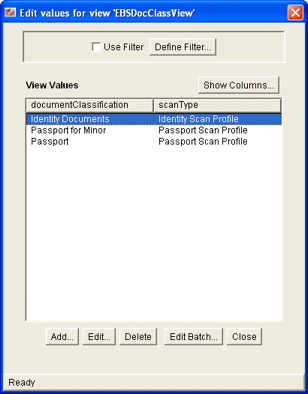
-
-
In the Edit Values screen, click Add and add document classifications and their corresponding scan profile. Note that documentClassification entries must be unique, but a scan profile can be used multiple times. Click Close when done.
-
From the Options menu, select Publish schema to publish the data.
6.6.5 Testing the Oracle Distributed Document Capture Via Adapter Configuration
Follow these steps to test the configuration as an end-user. For more information, see the Oracle Fusion Middleware User's Guide for Oracle Application Adapters for Oracle Enterprise Content Management.
-
Refresh the Managed Attachments results page. You should see a Scan button beside the New button.
-
Click the Scan button. In the Scan Document page, select a document classification and security group, and click Scan Document. The Oracle Distributed Document Capture client launches.
Note:
You can attach only one document via scanning or importing at a time.Notice that the URL reflects the settings you specified to run the client. It also passes the scan profile, scan action (1 = Scan and 2 = Import), and index data containing the Oracle E-Business Suite or Oracle PeopleSoft entity values.
-
Within the Oracle Distributed Document Capture client, review, index, and send the document.
Note:
If you decide to cancel a document scan or import, you must close the Oracle Distributed Document Capture screen and return to the Managed Attachments screen and perform a new scan or import. This ensures that index values are properly set for attachments. -
Return to the Managed Attachments page and click Refresh. The newly scanned document or imported scanned image file should display in the list. (It may take a few minutes to display.)
6.7 Customizing the Managed Attachments Solution
This section describes methods of customizing the Managed Attachments solution. It covers the following topics:
-
Section 6.7.1, "Customizing at Global, Application, and Business Entity Levels"
-
Section 6.7.2, "Customizing the Document Type Used For New Attachments"
-
Section 6.7.3, "Customizing the Content Server Profile Used"
-
Section 6.7.4, "Hiding or Displaying Managed Attachments Screen Buttons"
-
Section 6.7.6, "Customizing Managed Attachments Screen Images"
-
Section 6.7.7, "Customizing the Screen Style Sheet (CSS) Used"
-
Section 6.7.13, "Enabling the Paperclip with Attachments (Oracle E-Business Suite Only)"
6.7.1 Customizing at Global, Application, and Business Entity Levels
You can customize settings at global, application, and business entity (application+business entity) levels in the preferences.hda file. (For general information, see Section 6.3.3.) This setting enables you to configure a global value and then customize for specific business entities, as illustrated in Table 6-3.
Notes:
You must restart the Content Server after modifying the preferences.hda file.You can add or delete application and business entity configuration entries as needed, but do NOT delete global configuration entries from the preferences.hda file.
Table 6-3 Global, Application, and Business Entity Level Customization
| Level | Customization Parameters | Example |
|---|---|---|
|
Global |
Modify the appropriate resultset setting in the preferences.hda file. Specify: name value |
This entry sets the From Repository button to display globally for the adapter: AppAdapterRepoAttachBtnVisible true |
|
Application |
Copy and customize a resultset row, setting dAFApplication for the application. Specify: name value dAFApplication |
This entry hides the From Repository button in the EBS_instance application. AppAdapterRepoAttachBtnVisible false EBS_Instance |
|
Business Entity |
Copy and customize a resultset row, setting dAFApplication and dAFBusinessObjectType for the business entity. Specify: name value dAFApplication dAFBusinessObjectType |
This entry displays the From Repository button for the ExpenseClaims business entity only. AppAdapterRepoAttachBtnVisible true EBS_Instance ExpenseClaims |
6.7.2 Customizing the Document Type Used For New Attachments
A Content Server document type is selected by default when users click the New button to attach and check in a document. Using preferences.hda settings, you can specify a different default document type. In addition, you can specify document types on a global, application, or business entity level. For example, you might want to check in all new documents for an expenses business entity using a custom document type geared toward expense attachments.
Follow these steps.
-
On Content Server, create or modify a document type.
For more information about document types, see the Content Server documentation.
-
In the preferences.hda file, add a new row in the AFEnvironmentConfiguration resultset. For general information, see Section 6.3.3.
-
Insert an entry that identifies the document type to use as the default type for a specified business entity, where:
-
name: afDocTypevalue: document type keydAFApplication: Application to which to assign this document typedAFBusinessObjectType: Business entity within application to which to assign document type
Example 6-2 sets the document type ExpenseClaimsType as the default type when users attach documents to the ExpenseClaims business entity (within the PSFT_Instance application).
-
-
Restart the Content Server.
6.7.3 Customizing the Content Server Profile Used
The adapter provides a default Content Server profile for each business application, called EBSProfile for Oracle E-Business Suite and PSFTProfile for Oracle PeopleSoft. You can copy and customize the profile, then assign it using one of the methods described below, depending on customization needs. For example, you might want to add metadata fields to the profile.
Note:
If you use custom profiles, generic error messages display by default instead of application-specific error messages. To display custom error messages, override the resource include - af_custom_error_msg_display. In the overridden resource include, set the error message to afErrorMsg.6.7.3.1 Changing the Profile Globally
Follow these steps to change the global profile used.
-
From the Content Server Configuration Manager, copy the default profile provided (EBSProfile or PSFTProfile). To view these profiles, navigate to the Profiles tab in Configuration Manager.
-
Add new rules as needed. For example, add new metadata fields.
-
In the UCM_CONNECTION_STR parameter (trigger value) of the AXF_SOLUTION_PARAMETERS table, modify the URL to point to the new profile.
For more information, see Section B.1.3.
6.7.3.2 Specifying a Profile For a Specific Business Entity or Application
Follow these steps to modify the profile for a specific business entity or application.
-
From the Content Server Configuration Manager, copy the default profile provided (EBSProfile or PSFTProfile). To view these profiles, navigate to the Profiles tab in Configuration Manager.
-
Add new rules as needed. For example, add new metadata fields.
-
In the preferences.hda file, add a new row in the AFEnvironmentConfiguration resultset. For general information, see Section 6.3.3.
-
Insert an entry that identifies the Content Server profile to use for a specified business entity, where:
-
name: dpTriggerValuevalue: Key of new Content Server profiledAFApplication: Application to which to assign this profiledAFBusinessObjectType: Business entity within application to which to assign the profile
Example 6-3 sets a profile called OrderPayableProfile for use when users attach or scan documents in the OrderPayables business entity within the EBS_Instance application.
-
-
Restart the Content Server.
6.7.4 Hiding or Displaying Managed Attachments Screen Buttons
You can choose to disable (hide) or display the buttons listed in Table 6-4 to users on the Managed Attachments screen, by changing their environment variable setting to false. For details about Oracle UCM configuration variables, see Section 6.3.3.
Table 6-4 Environment Variables For Displaying or Hiding Managed Attachments Buttons
| Environment Variable | Description |
|---|---|
|
AppAdapterRepoAttachBtnVisible |
Displays or hides the From Repository button |
|
AppAdapterRefreshBtnVisible |
Displays or hides the Refresh button |
|
AppAdapterConfigureBtnVisible |
Displays or hides the Configure button |
|
AppAdapterDetachBtnVisible |
Displays or hides the Detach button |
|
AppAdapterCheckinNewBtnVisible |
Displays or hides the New button |
|
AppAdapterScanBtnVisible |
Displays or hides the Scan button |
|
AppAdapterAutoVueIconVisible |
Displays or hides the AutoVue button in the Actions column |
Follow these steps to hide or display a button globally, or for a specific business entity or application.
-
In the preferences.hda file, add a new row in the AFEnvironmentConfiguration resultset.
-
Insert an entry that identifies the button from the list in Table 6-4 to disable or enable, and the level.
Example 6-4 displays the From Repository button globally but then hides it for the ExpenseClaims business entity (within the EBS_Instance application).
-
Restart the Content Server.
6.7.5 Customizing Scanning
This section describes methods of customizing scanning functionality using Oracle Distributed Document Capture. It includes the following topics:
-
Section 6.7.5.2, "Configuring an Alternate Scan Profile For a Business Entity"
-
Section 6.7.5.3, "Modifying the Document Classification Used"
For information about configuring standard scanning options, see Section 6.6. For information about the preferences.hda file, see Section 6.3.3.
6.7.5.1 Enabling or Disabling Scanning
You can enable or disable scanning at the global, application, or business entity level. In Example 6-5, scanning is disabled globally but enabled for the OrderPayables business entity.
6.7.5.2 Configuring an Alternate Scan Profile For a Business Entity
The adapter provides two default business application scan profiles. Each points to an application-specific field:
-
EBSScanProfile references the EBSAppScanProfiles application field
-
PSFTScanProfile references the PSFTAppScanProfiles application field
You can customize the scan profile used, by copying the profile appropriate for your business application, modifying it to reference another application field, and configuring it for one or more business entities, as described in the following steps.
-
Copy the scan profile that applies to your business application, saving it with a new name.
-
Create all required schema elements, including the AppScanProfiles application field, table, and view.
To change the application field reference, log in to Oracle UCM. In Configuration Manager, navigate to the Rules tab. Select PSFTScanRule or EBSScanRule, click Edit on the Side Effects tab, and update the ScanProfileKey field to point to another application field.
-
In the preferences.hda file, add a new row in the AFEnvironmentConfiguration resultset.
-
Insert an entry that includes the afScanProfile setting, identifies the scan profile to use, and the application and business entity in which it applies.
Example 6-6 shows a scan profile called MyPIMScanProfile enabled for the PIM business entity only.
6.7.5.3 Modifying the Document Classification Used
The adapter provides two default business application document classifications for scanning. Each classification includes a set of Oracle UCM application fields, a table, and a view.
-
For Oracle E-Business Suite, the adapter provides EBSAppScanProfiles (fields), EBSDocClass (table), and EBSDocClassView (view)
-
For Oracle PeopleSoft, the adapter provides PSFTAppScanProfiles (fields), PSFTDocClass (table), and PSFTDocClassView (view)
To modify the classification, perform the following steps.
-
Log in to Oracle UCM. In Configuration Manager, navigate to the EBSDocClassView or PSFTDocClassView.
-
Edit the document classification and scan type values. For more information, see Section 6.6.4.
6.7.6 Customizing Managed Attachments Screen Images
The adapter provides standard images for Managed Attachments display, which you can customize. For example, you might change the Oracle blue waves image with one specific for your organization. To change images, override the resource include af_ebs_define_image_locations. For sample implementations, see AppAdapter_JS_resource.htm for Oracle E-Business Suite or ps_AppAdapter_Js_resource.htm for Oracle PeopleSoft.
Note:
Customizing images for Managed Attachments requires advanced knowledge of Content Server configuration and customization. Be sure to back up the appropriate files before making modifications.6.7.7 Customizing the Screen Style Sheet (CSS) Used
The adapter provides a standard style sheet for the Managed Attachments screen. You can change it by overriding resource includes. For sample implementations, see AppAdapter_CSS_resource.htm for Oracle E-Business Suite or ps_AppAdapter_CSS_resource.htm for Oracle PeopleSoft.
Note:
Customizing style sheets for Managed Attachments requires advanced knowledge of Content Server configuration and customization. Be sure to back up the appropriate files before making modifications.6.7.8 Configuring Relationship Attributes
Relationship attributes allow you to store relationship metadata (information about relationships between a document and its business entity) upon attaching documents in Managed Attachments. For example, suppose you have one document attached to two work order entities (WO1 and WO2), and want to allow users to print the document from WO1, but not from WO2. In this case, you would create a print attribute as an application field on Content Server, and then specify a print relationship attribute for the WO1 business entity in the preferences.hda file. The print attribute would be displayed on the Update page to end-users for the WO1 entity only, allowing them to print the attached document.
Important Points About Relationship Attributes
-
You can configure relationship attribute for new document check-in, but not for documents checked in through scanning.
-
At run-time, relationship attribute values are stored in the AFRelationshipAttributes table; see Section B.4.3.
Follow these steps to configure relationship attributes.
-
On Content Server, open Configuration Manager and navigate to the Application Fields tab.
-
Add one or more application fields.
-
Navigate to the Rules tab.
-
Edit the AFRelationshipAttributes rule. Add the application fields you added in step 2 to this rule.
-
Open the preferences.hda file and add a new row in the AFRelationshipAttributes resultset. (For general information, see Section 6.3.3.)
Each row in the resultset represents one relationship attribute associated with a business object, where:
-
dAFApplication refers to the Oracle E-Business Suite or Oracle PeopleSoft business application for which the relationship attribute is configured.
-
dAFBusinessObjectType refers to the Business Object for which to enable the relationship attribute.
-
attribute refers to the relationship attribute.
Example 6-7 shows a relationship attribute (Print) configured for an WO1 business object for an Oracle PeopleSoft application.
-
-
Save and restart Content Server.
6.7.9 Configuring Revision-Specific Mode
By default, each attachment in the Managed Attachments screen provides access to the most recent revision of the document. In certain cases, however, you may want to configure one or more business entities to provide access to the revision that was attached, even if the document was later updated on Content Server. In this mode, users can see that a more recent revision exists, and if needed, view it and make it the attached revision.
Follow these steps to configure a business entity to display the attached revision instead of the most recent revision.
-
Open the preferences.hda file, and add a new row in the AFRevisionSpecificEntities resultset. (For general information, see Section 6.3.3.)
Each row in the resultset represents one business entity for which to enable revision specific attachments, where:.
-
dAFApplication refers to the business application for which to enable the revision feature.
-
dAFBusinessObjectType refers to the business object for which to enable the revision feature.
Example 6-8 shows revision-specific mode configured for a CallRecords business object for an Oracle E-Business Suite application.
-
6.7.10 Changing the Result Count
The Managed Attachments screen displays a specific number of attachment results per page (referred to as ResultCount). If the number of results exceeds ResultCount, previous and next page controls display on the screen. By default, ResultCount is set to 5. You can change it to another number (such as 20) by specifying a new ResultCount number in the UCM_CONNECTION_STR parameter of the AXF_SOLUTION_PARAMETERS Table. Also see Section B.1.3.2, "Example Implementations."
6.7.11 Changing the Result Template
The Managed Attachments screen uses a result template to determine its display. The Content Server result template specifies the Managed Attachments user interface. The adapter provides two default result templates:
-
The Oracle E-Business Suite template, adapter_list_results_template.htm, is referred to as EBS_LIST.
-
The Oracle PeopleSoft template, ps_adapter_list_results_template.htm, is referred to as PSFT_LIST.
Follow these steps to identify an alternate result template for an application or business entity.
Note:
Customizing the result template requires advanced knowledge of Content Server administration and customization.-
Create a copy of the Oracle E-Business Suite or Oracle PeopleSoft default result template and register the template with a new name, preferably in a new component.
-
The Oracle E-Business Suite template is located at:
UCM_HOME/custom/AppAdapterEBS/adapter_list_results_template.htm -
The Oracle PeopleSoft template is located at:
UCM_HOME/custom/AppAdapterPSFT/ps_adapter_list_results_template.htm
-
-
In the preferences.hda file, add an entry in the AFEnvironmentConfiguration section as follows:
ResultTemplate <Template Reference> <Application Name> <Business Entity>
In Example 6-9, all requests to Managed Attachments for the WorkOrder business entity would use the EBS_WORK_ORDER_LIST custom result template instead of the default Oracle E-Business Suite template.
6.7.12 Setting Default Columns
You can specify the default columns to display to users in the Managed Attachments screen. (When the user clicks Reset in the Configure Fields for Display screen, default columns are listed in the Main Information section of the screen.)
The column defaults are title, type, author, date, and revision as follows:
dDocTitle,dDocType,dDocAuthor,dInDate,dRevision
To set alternate default columns for an application or business entity, follow these steps.
-
In the preferences.hda file, add an entry in the AFEnvironmentConfiguration section.
-
Set the value of the AppAdapterDefaultDisplayColumns configuration variable as a comma-delimited list containing Oracle UCM metadata field names.
In Example 6-10, the first entry sets document title, type, author, and date as the default columns for the EBS_Instance application. The second entry overrides this setting for the CallRecords business entity by adding the revision column (dRevision) as a default column.
6.7.13 Enabling the Paperclip with Attachments (Oracle E-Business Suite Only)
By default, the Oracle E-Business Suite paperclip attachment option is disabled as part of Managed Attachments configuration. To use this native Oracle E-Business Suite attachments feature in coexistence with the Managed Attachments solution, you must reenable the paperclip icon as described below.
Note:
This section applies to Oracle E-Business Suite use only.-
Add the following row to the AXF_PROPERTIES table:
Table 6-5 AXF_PROPERTIES Values For PaperClip Use
PROPNAME PROPVALUE AXF_PAPERCLIP
Set to
trueto enable the paperclip option, orfalse(default) to disable it.For more information, see Section B.2.5.
6.8 Configuring Oracle UCM Logging
For information about Oracle UCM Content Server logging, see the Oracle Fusion Middleware System Administrator's Guide for Universal Content Management.
6.9 Uninstalling Adapter Components on Content Server
Follow these steps to disable and then uninstall the following adapter components on the Content Server.
-
AppAdapterCore
-
AppAdapterEBS
-
AppAdapterPSFT
For details about these components, see Section 6.3.1.
-
Log in to Content Server as an administrator.
-
Select Admin Server from the Administration menu.
The Content Admin Server page displays.
-
Click the name of the Content Server instance from which to uninstall the component.
The Content Admin Server <instance_name> page displays.
-
Click Component Manager.
The Component Manager page displays.
-
Select an adapter component in the Enabled Components list and click Disable.
-
Repeat step 5, selecting and disabling the remaining adapter components.
-
Click Start/Stop Content Server.
The Content Admin Server <instance_name> displays.
-
Click Restart.
-
Click Component Manager.
The Component Manager displays.
-
Select an adapter component in the Uninstall Component field and click Uninstall. Click OK to confirm uninstalling the component.
-
Repeat step 10, uninstalling the remaining adapter components.
-
Select the link to return to the Component Manager.
The Component Manager page displays.
-
Click Start/Stop Content Server.
The Content Admin Server <instance_name> page displays.
-
Restart Content Server to apply the changes.
